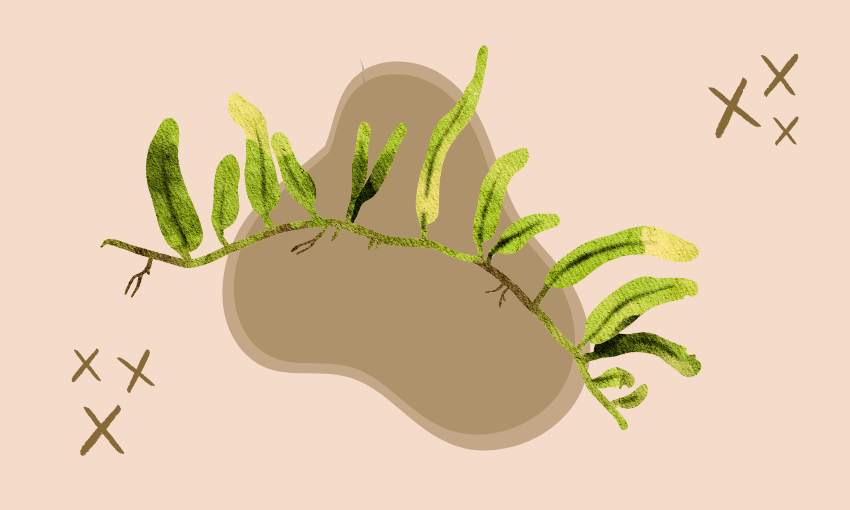A new documentary examines the impact the invasive algae caulerpa is having on a community that depends on kaimoana.
In 2021, while the country was distracted with the final Covid lockdowns and what Te Pāti Māori co-leader Rawiri Waititi was wearing around his neck, a silent killer was taking over our waters. It wasn’t a foreign navy or microplastics, but a type of invasive algae suffocating everything in its path.
Described as the “cancer of the sea” and “a national emergency”, exotic caulerpa is already drastically changing New Zealand’s seafloor habitat, and it appears the problem is only going to get worse. Officials don’t know exactly where or when the toxic, sticky green algae first entered New Zealand waters, but it is believed to have arrived on a vessel travelling from Australia or the Pacific.
It was initially discovered on the west coast of Aotea in the outer Hauraki Gulf in July 2021, but the Ministry for Primary Industries says the amount of caulerpa found in various locations suggests it had already been here for several years. “It is chaos… No one’s got a handle on it. No one,” says Aotea kaumātua Rodney Ngawaka (Ngāti Rehua – Ngāti Wai ki Aotea) in Mauri Moana, a new documentary focusing on the impact caulerpa is having on Aotea.
In the three years since it was first found, caulerpa has covered the seafloor along the entire western coast of Aotea and is now beginning to spread to the eastern coast. It has also been found as far south as Ahuahu, near the Coromandel Peninsula, and as far north as Pēwhairangi. According to Chris Ollivier, co-chair of the Aotea Caulerpa Response Team, large infestations of caulerpa overseas have led to 50% loss of amenity, or use of the area, and 50% loss of the fish life in those areas.
“Our identity of who we are as Ngāti Rehua – Ngāti Wai ki Aotea people, our identity will change because of [the loss of] our food source,” says Ngawaka.
Nathaniel Howe (Ngāti Wai, Te Whānau-ā-Apanui, Ngāti Porou, Ngāi Tahu, Ngāpuhi) and Stevie Davis-Tana (Ngāpuhi, Ngāti Porou ki Harataunga, Te Arawa, Ngāti Raukawa ki te Tonga) are the director and producer of Mauri Moana. The duo were documenting historical kōrero for local iwi and looking at contemporary issues when they realised there was a lack of awareness about the impact caulerpa was having on the people who are “very connected to the taiao and live a lifestyle that requires them to be connected intimately with the moana”, Howe says.
While there is great awareness and politicisation around issues like deep sea mining, Howe says there needs to be an increased focus on caulerpa, which is already having a huge impact on the ocean environment, but there’s been “a lack of response over the last three years to tackle the problem”.
Locals in Aotea have been enforcing rāhui, or controlled areas, and carrying out their own surveillance and removal efforts, but the problem is larger than any small-scale community initiative can tackle alone. Since caulerpa spreads via ocean currents, removal in one place can be undone after a storm or strong swell. “Because of how far it’s spread and how quickly it’s spread, it requires critical mass,” Howe says.
In August, the minister for biosecurity Andrew Hoggard announced the government would be adding an extra $10m in funding to develop tools and techniques to contain and remove exotic caulerpa, bringing the total amount of government funding to $15m in the three years since it was first discovered here.
Last month, the Northland Regional Council said its world-first caulpera eradication trials were removing tonnes of caulerpa from the seafloor every day in Pēwhairangi.
Despite the positive news, there are fears that progress is too slow and not happening at a large enough scale to effectively tackle the issue. According to the Northland Regional Council, $100 million is needed to fight the invasive species nationwide.
“The Pākehā perspective looks at the economic impact at a macro level. The Māori perspective looks at the whakapapa impact – both are equally valuable in terms of being able to quantify what the issue is,” says Howe. “What we need to do is accelerate the awareness, so that everyone understands and is aware of what is at stake… When you’re dealing with the bureaucracy that we’re dealing with, the government is really slow to put enough resources into tackling the problem.”
According to Izzy Fordham, chair of the Aotea/Great Barrier local board, a key reason the issue has seemingly flown under the radar for so long is that caulerpa exists under the water, where most people can’t see the impact it is having on the environment. In other words, it is literally out of sight, out of mind.
“Because it is underwater and you can’t see it, you don’t really resonate with how serious it is… I don’t think the government truly understands what is at stake here,” Fordham says.
While bureaucracy is being blamed for an apparent lack of adequate action and resourcing from the government, caulerpa continues to destroy vital sources of kaimoana generations of New Zealanders have depended on. Just how bad the problem will get remains to be seen. But for Howe, the solution needs to be now. “I’d hate to have to write an apology letter to our kids and to our grandkids, because at this time, this point right here, we said nothing and did nothing about it.”
This is Public Interest Journalism funded by NZ On Air.
